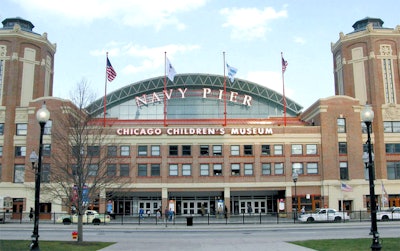
Whether based on sexism, racism, or classism, attitudes about bathrooms have a long history of not being inclusive. Today, more people are discussing the need for bathrooms to become gender-inclusive as the trans and gender-non-conforming rights movement gains momentum, and as new venues like hotels, museums, and other spaces purposefully build them into designs. But what does it mean to have gender-inclusive or neutral bathrooms, and how can already existing venues adjust to meet the needs of guests, as well as planners who require gender-neutral facilities in R.F.P.s?
“Public access to facilities affect all of us: Our comfort, our health needs—there are so many reasons why having an accessible restroom is important to any patron that is in a public space,” says Courtney D’Allaird, assistant director and coordinator of the Gender & Sexuality Resource Center at the University at Albany, SUNY. “There’s no law that requires us to have segregated bathrooms. We just do it.”
The numbers don’t lie: Studies find that Generation Z is going to be the most transgender accepting and identifying generation ever. So as the push for gender inclusivity intensifies, venues and public spaces would be wise to consider how they can adjust. It may seem difficult to change bathrooms that have already been segregated by gender, but the process—especially when it comes to event planning—is much simpler than some may perceive it to be.
“All you have to do is make your laminated sign that says this bathroom is for everyone,” says D’Allaird. “It’s fine to tape off urinals [as well]. If there’s a worry about that, put some caution tape over the open urinals.”
D’Allaird also suggests simply putting a photo of what’s inside the bathroom on the sign: If it contains only stalls, put a photo of just a toilet. If it’s stalls and urinals, place that on the sign without gendering it. That way visitors and patrons can decide which bathroom aligns best with their gender identity.
A common practice is to transform single-stall bathrooms/family restrooms into gender-inclusive ones. That’s precisely what the Dallas Central Library did.
“At our central library, we’ve converted two single-stall restrooms to be gender-neutral,” says Clinton Lawrence, assistant director of operations and facilities at the Dallas Library. “Moving forward with new construction and renovation, we’re including [more] gender-neutral restrooms.”
In addition to making the restrooms available, Lawrence’s team ensures that everyone who enters the facility is aware of the bathroom options to make sure they know where to go.
“We saw a need to adapt and our philosophy is that all are welcome, so we wanted to be accommodating to that,” he says. “Depending on the program [or event] type, we might specifically say, ‘Here are the gender-neutral restrooms available on these floors.’ We remind people where our restrooms are located constantly.” The Chicago Children’s Museum's signs are meant to send a message of inclusivity.Photo: Courtesy of Chicago Children's Museum
The Chicago Children’s Museum's signs are meant to send a message of inclusivity.Photo: Courtesy of Chicago Children's Museum
The team at the Chicago Children’s Museum has adopted similar practices. In 2011, they formed an L.G.B.T.Q. Inclusive Initiative and soon after placed all-gender bathroom signs on single-stall restrooms.
“We knew [these symbols] were really important for this group that feels completely under welcomed,” says Katie Slivovsky, exhibit development director and co-chair of the L.G.B.T.Q. Inclusion Team. “Historically L.G.B.T.Q. people have been really rendered invisible in public places, so by putting these two very public signs out there we illustrate our commitment to this community.”
Slivovsky states that the museum has had an overwhelmingly positive response.
“The signs not only are important for transgender and gender-nonconforming people, but they do send that message of welcome and a lot of folks see that and feel that and get it and like it. Inclusion feels good. Our primary goal is to provide a safe space for our visitors to go to the bathroom.”
She adds, “Having a safe space to go to the bathroom is a human right; it should not be optional.”
Similar measures are being taken at the Walker Art Center in Minneapolis. All single-unit restrooms there have been made gender-neutral, which aligns with the center’s mission statement about inclusivity.
“It aligns with our mission and our community, and it’s important that we provide that,” says David Goldstein, associate director of visitor services. “It’s a very straightforward and easy process. It was the clearest path for us, the only path.”
It’s important for planners to discuss options with venues since it can affect the guest experience. While converting single-stall restrooms is often the most common—and simplest—measure to take, other options are available. Some venues have opted for a shared sink setup, while keeping separate, gendered stalls. Others adjust signage for the duration of the event.
At the Shed arts center, which opened in April in New York’s Hudson Yards development, a message under the “Women” and “Men” restroom signs says: “While the law requires gender binary signs, we support gender diversity. Please use the restroom that feels most comfortable for you.” At the 21c Museum Hotels in Durham, North Carolina, and Kansas City, Missouri, signs saying “Everyone All Ways” have been placed outside restrooms. The sign, which went viral, was designed by artist Peregrine Honig and instantly informs those visiting the hotel that no matter how they identify, they are welcome. 21C Museum Hotels's gender-neutral bathroom sign, designed by artist Peregrine Honig, went viral.Photo: Courtesy of 21C Museum Hotels
21C Museum Hotels's gender-neutral bathroom sign, designed by artist Peregrine Honig, went viral.Photo: Courtesy of 21C Museum Hotels
D’Allaird cautions against placing gender-inclusive bathrooms far away from the main event area. If your event is on the first floor, make the first-floor bathrooms inclusive while designating the bathrooms on the other floors gendered for people who would prefer to use those. Proper signage is also necessary, as well as having knowledgeable staff available who can assist visitors in finding the bathroom they are most comfortable using.
In the end, the reason for having gender-inclusive bathrooms is simple: Safe bathroom access is a human right. When planning an event, it’s vital to discuss the topic with venues in order to find temporary or permanent solutions that result in the most comfortable and welcoming experience possible.
This story appeared in BizBash's Fall 2019 issue.



















